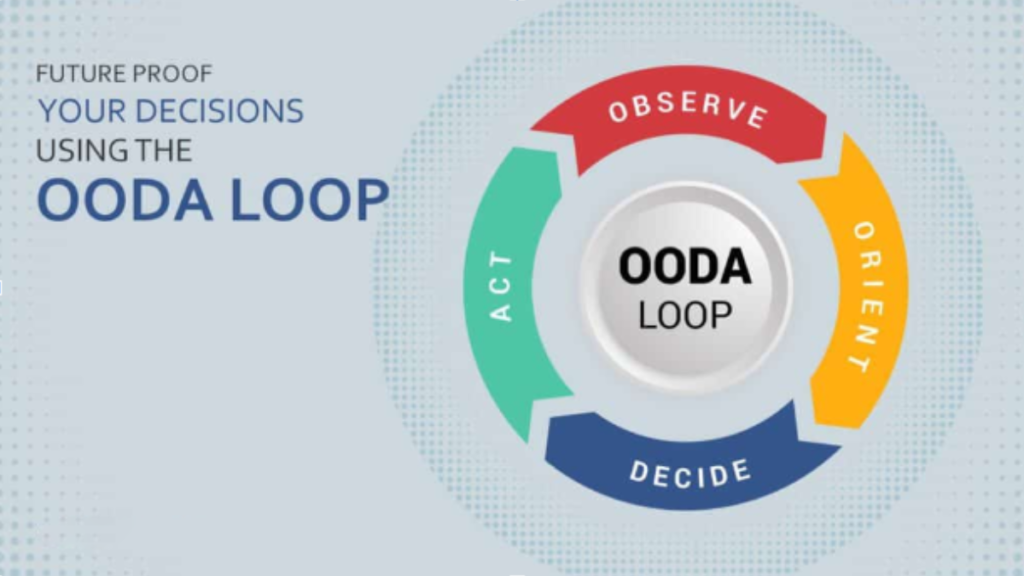When starting a new business or even running an existing one, decision-making is a difficult piece that requires a lot of thought and has no ready answers. After all, your decisions can have far-reaching consequences that could affect future courses of action and have long-term effects. And that responsibility requires a lot of foresight and experience to bear successfully.
In the process of decision-making, several techniques go on almost simultaneously in our minds. To showcase such decision-making, using certain PowerPoint themes can prove very valuable. Subconsciously, we’re often analyzing and trying to figure out the consequences of each iteration before finalizing a decision. And it is using this idea that the OODA loop was developed as a framework for smart and strategic decision-making.
What is the OODA Loop?
Table of Contents
The American military strategist and the United States Air Force Colonel John Boyd developed the OODA Loop. It was a framework used to devise strategies for combating opposition and developing operational combat strategies. What is interesting, however, is that Boyd’s concept of the OODA loop is not specific to the military concept.
It is now considered a highly effective framework for managing litigation, business, and even learning operations. At its root, the OODA loop functions on automatic reactions of the brain to external stimuli, and it tries to articulate the analyses we do every time we have to make a decision.
The OODA Loop stands for Observe-Orient-Decide-Act and is a cyclical framework that relies on four major decision-making components. Usually used as a loop diagram, it can also be used as a flow diagram. The main idea is that it should communicate your process effectively, regardless of the diagram employed.
In making an OODA loop, it is essential to understand what each step of the process entails.
Observe
In this stage, you should be focused on collecting information. Acquire raw data, statistics, primary research, and other important information to facilitate decision-making. Most of the data come from careful observation of the situation and trying to analyze internal and external factors that can affect your operations. A good practice to follow is to assume you are an outsider looking into the situation. It helps keep your objectivity while eliminating potential biases in your observations.
Orient
The next step involves removing biases from our observations. This implies you are orienting yourself in the right direction, and your decision will be based on pragmatic data and no preconceived biases. Five things to look for include culture, genetics, ability to analyze and synthesize, and previous experience. These factors can affect how we process information, so we must be conscious and orient ourselves for a fruitful decision-making process.
Decide
This is where active planning takes place. Once you have collated your information in a clear-cut, bias-free manner, you can create a working document that outlines your decision based on your information. Based on the data, deciding what to do is essential to this process, and you will choose the outcomes of your planning and execution. It also enables the cycle to continue as this decision may be revised repeatedly. It undergoes multiple iterations of the same process to optimize and strategize the right decision for an organization. This step should involve critical thinking and analysis of judgments versus consequences.
Act
Once you have a decision in place and an exhaustive plan for its execution, the only thing left is the physical execution of a strategy. It can be easy to fall into the trap of doing excessive research and analysis without ever converting it into an actionable plan. This is a crucial step in the OODA loop as it allows for abstract and virtual ideas to become a reality with real-world implications.
It is with the data collected as a result of the physical execution of a decision that the OODA loop cycles back to the beginning, as the process repeats itself over and over, learning something new and eliminating wasteful information and actions in the process.
What are the uses of the OODA Loop?
Adaptability in a Competitive Market
One of the biggest uses of the OODA loop is to counter your business competitors. After all, the concept was devised as a combatant strategy. But how exactly the OODA loop helps in that it is a long process of constant iterations and multiple loops working simultaneously? The main idea is that by collecting information about your competitors, you can feed them to an OODA loop and understand how that information affects their standing in the market. Another OODA loop is involved in understanding customer data and what clients seek.
Once you’ve got the information, analyze and develop a business plan that effectively orients you to the market better than your competitors, giving you a significant advantage. This is what is meant by a firm’s adaptability, and being able to analyze and act upon changes in the market constantly makes the OODA loop so effective.
Identifying Patterns of Behaviour
An OODA loop can function on two ends to analyze patterns of behavior. It can attempt to analyze your firm’s functioning based on its strengths and weaknesses and find ways to capitalize on the strengths while eliminating or improving on the weaknesses.
On the other hand, it can also look for patterns of behavior of your target demographic and consumers and allow you to orient your processes to the requirements and expectations of your consumers. By identifying behavior patterns, you can make an educated guess about consumer response to any new product or service you intend to put out.
Creating Quick Responses
By studying market trends and your competitor’s processes, an OODA loop can enable you to make quick decisions about sudden changes in the market, demographic or company processes. And being quicker than your competitors to respond is the most important aspect of combating your competitors with sound planning and decision-making.
Alternatively, having quick responses can result from orienting your OODA loop and decision-making process toward the future. Analyzing top and upcoming market trends and trajectories can help you scope out a possible plan for the future and orient your processes to give you a headstart over your competitors.
Pros and Cons of OODA Loop in Decision-Making:
As with every model and framework, the OODA Loop has significant advantages and disadvantages it can offer decision-makers. It is essential to understand these to utilize the OODA Loop effectively.
Pros
- Good at adapting to messy and disorganized markets. Using the OODA Loop makes quick decision-making based on ever-changing data possible and simple.
- It allows you to gain a competitive advantage by disrupting a competitor’s decision-making process.
- In this age of data, it is a model that allows your organization to become data-driven and allows for solely planning based on evidence rather than experience and intuition.
Cons
- There is no scientific basis for the OODA Loop. All evidence of its functioning is rooted in anecdotal evidence.
- It is not the easiest decision-making framework, as it requires a lot of legwork to be effective. Moreover, its processes are open to interpretation, making them slightly volatile.
- It can create the illusion of credibility if incorrect or incomplete data is used to formulate plans.
- It does not account for reusing tactics for similar situations, as the loop only functions in its entirety, and isolated elements cannot function independently.
CONCLUSION
Perhaps an audacious statement, but every business functions almost like a battlefield, with a well-oiled battalion of employees and leaders working in tandem to reach their goals. And so, it makes sense that a decision-making framework with its roots in the military can be as effective as it is in tackling business decisions. The OODA Loop is an excellent resource for leaders who want to make decisions rooted in incredible data and can be sure of the results to a certain extent.


